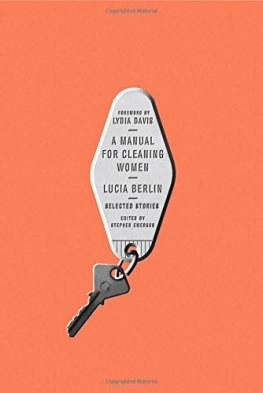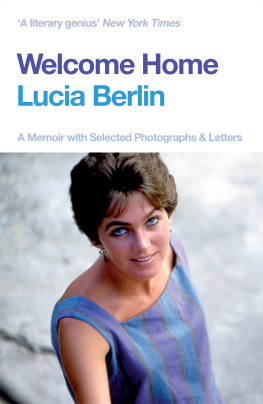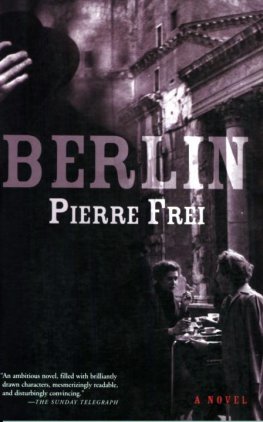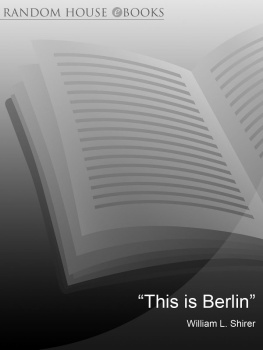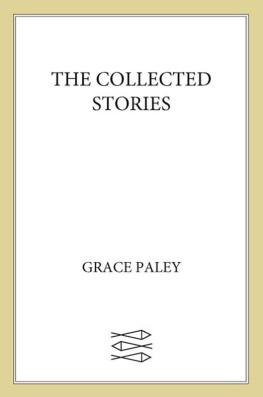Lucia Berlin
A Manual for Cleaning Women: Selected Stories
Foreword: The Story Is the Thing by Lydia Davis
Lucia Berlins stories are electric, they buzz and crackle as the live wires touch. And in response, the readers mind, too, beguiled, enraptured, comes alive, all synapses firing. This is the way we like to be, when were reading using our brains, feeling our hearts beat.
Part of the vibrancy of Lucia Berlins prose is in the pacing sometimes fluent and calm, balanced, ambling and easy; and sometimes staccato, notational, speedy. Part of it is in her specific naming of things: Piggly Wiggly (a supermarket), Beenie-Weenie Wonder (a strange culinary creation), Big Mama panty hose (a way to tell us how large the narrator is). It is in the dialogue. What is that exclamation? Jesus wept. Well, Im blamed! The characterization: The boss of the switchboard operators says she can tell when its close to quitting time by the behavior of Thelma: Your wig gets crooked and you start talking dirty.
And there is the language itself, word by word. Lucia Berlin is always listening, hearing. Her sensitivity to the sounds of the language is always there, and we, too, savor the rhythms of the syllables, or the perfect coincidence of sound and sense. An angry switchboard operator moves with much slamming and slapping of her things. In another story, Berlin evokes the cries of the gawky raucous crows. In a letter she wrote to me from Colorado in 2000, Branches heavy with snow break and crack against my roof and the wind shakes the walls. Snug though, like being in a good sturdy boat, a scow or a tug. (Hear those monosyllables, and that rhyme.)
* * *
Her stories are also full of surprises: unexpected phrases, insights, turns of events, humor, as in So Long, whose narrator is living in Mexico and speaking mostly Spanish, and comments a little sadly: Of course I have a self here, and a new family, new cats, new jokes. But I keep trying to remember who I was in English.
In Panten de Dolores, the narrator, as child, is contending with a difficult mother as she will in several more stories:
One night after he had gone home she came in, to the bedroom where I slept with her. She kept on drinking and crying and scribbling, literally scribbling, in her diary.
Are you okay? I finally asked her, and she slapped me.
In Dear Conchi, the narrator is a wry, smart college student:
Ella, my roommate I wish we got along better. Her mother mails her her Kotex from Oklahoma every month. Shes a drama major. God, how can she ever play Lady Macbeth if she cant relax about a little blood?
Or the surprise can come in a simile and her stories are rich in similes:
In A Manual for Cleaning Women, she writes, Once he told me he loved me because I was like San Pablo Avenue.
She goes right on to another, even more surprising comparison: He was like the Berkeley dump.
And she is just as lyrical describing a dump (whether in Berkeley or in Chile) as she is describing a field of wildflowers:
I wish there was a bus to the dump. We went there when we got homesick for New Mexico. It was stark and windy and gulls soared like nighthawks in the desert. You can see the sky all around you and above you. Garbage trucks thunder through dust-billowing roads. Gray dinosaurs.
* * *
Always embedding the stories in a real physical world is just this kind of concrete physical imagery: the trucks thunder, the dust billows. Sometimes the imagery is beautiful, at other times it is not beautiful but intensely palpable: we experience each story not only with our intellects and our hearts, but also through our senses. The smell of the history teacher, her sweat and mildewed clothing, in Good and Bad. Or, in another story, the sinking soft tarmac the dust and sage. The cranes flying up with the sound of shuffling cards. The Caliche dust and oleander. The wild sunflowers and purple weed in yet another story; and crowds of poplars, planted years before in better times, thriving in a slum. She was always watching, even if only out the window (when it became hard for her to move): in that same letter of 2000 to me, magpies dive-bomb for the apple pulpquick flashes of aqua and black against the snow.
A description can start out romanticthe parroquia in Veracruz, palm trees, lanterns in the moonlightbut the romanticism is cut, as in real life, by the realistic Flaubertian detail, so sharply observed by her: dogs and cats among the dancers polished shoes. A writers embrace of the world is all the more evident when she sees the ordinary along with the extraordinary, the commonplace or the ugly along with the beautiful.
She credits her mother, or one of her narrators does, with teaching her that observant eye:
We have remembered your way of looking, never missing a thing. You gave us that. Looking.
Not listening though. Youd give us maybe five minutes, to tell you about something, and then youd say, Enough.
The mother stayed in her bedroom drinking. The grandfather stayed in his bedroom drinking. The girl heard the separate gurgling of their bottles from the porch where she slept. In a story, but maybe also in reality or the story is an exaggeration of the reality, so acutely witnessed, so funny, that even as we feel the pain of it, we have that paradoxical pleasure in the way it is told, and the pleasure is greater than the pain.
* * *
Lucia Berlin based many of her stories on events in her own life. One of her sons said, after her death, Ma wrote true stories, not necessarily autobiographical, but close enough for horseshoes.
Although people talk, as though it were a new thing, about the form of fiction known in France as auto-fiction (self-fiction), the narration of ones own life, lifted almost unchanged from the reality, selected and judiciously, artfully told, Lucia Berlin has been doing this, or a version of this, as far as I can see, from the beginning, back in the 1960s. Her son went on to say, Our family stories and memories have been slowly reshaped, embellished and edited to the extent that Im not sure what really happened all the time. Lucia said this didnt matter: the story is the thing.
Of course, for the sake of balance, or color, she changed whatever she had to, in shaping her stories details of events and descriptions, chronology. She admitted to exaggerating. One of her narrators says, I exaggerate a lot and I get fiction and reality mixed up, but I dont actually ever lie.
Certainly she invented. For example, Alastair Johnston, the publisher of one of her early collections, reports this conversation: I love that description of your aunt at the airport, he said to her, how you sank into her great body like a chaise. Her answer was: The truth is no one met me. I thought of that image the other day and as I was writing that story just worked it in. In fact, some of her stories were entirely made up, as she explains in an interview. A person could not think he knew her just because he had read her stories.
* * *
Her life was rich and full of incident, and the material she took from it for her stories was colorful, dramatic, and wide-ranging. The places she and her family lived in her childhood and youth were determined by her father where he worked in her early years, then his going off to serve in WWII, and then his job when he returned from the war. Thus, she was born in Alaska and grew up first in mining camps in the west of the U.S.; then lived with her mothers family in El Paso while her father was gone; then was transplanted south into a very different life in Chile, one of wealth and privilege, which is portrayed in her stories about a teenage girl in Santiago, about Catholic school there, about political turbulence, yacht clubs, dressmakers, slums, revolution. As an adult she continued to lead a restless life, geographically, living in Mexico, Arizona, New Mexico, New York City; one of her sons remembers moving about every nine months as a child. Later in her life she taught in Boulder, Colorado, and at the very end of it she moved closer to her sons, to Los Angeles.

